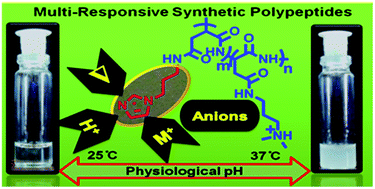Pronounced influence of pH, metal-ion and solvent isotope on the thermoresponse of synthetic amphiphilic polypeptides
Abstract
This contribution reports a series of novel amphiphilic

* Corresponding authors
a
Department of Chemistry, Indian Institute of Science Education and Research Bhopal, ITI Gas Rahat Building, Govindpura, Bhopal – 462023, Madhya Pradesh, India
E-mail:
asri@iiserb.ac.in
Web: http://home.iiserbhopal.ac.in/~asrivastava/
Fax: +91-755-4092392
This contribution reports a series of novel amphiphilic

 Please wait while we load your content...
Something went wrong. Try again?
Please wait while we load your content...
Something went wrong. Try again?
A. Sharma and A. Srivastava, Polym. Chem., 2013, 4, 5119 DOI: 10.1039/C3PY00741C
To request permission to reproduce material from this article, please go to the Copyright Clearance Center request page.
If you are an author contributing to an RSC publication, you do not need to request permission provided correct acknowledgement is given.
If you are the author of this article, you do not need to request permission to reproduce figures and diagrams provided correct acknowledgement is given. If you want to reproduce the whole article in a third-party publication (excluding your thesis/dissertation for which permission is not required) please go to the Copyright Clearance Center request page.
Read more about how to correctly acknowledge RSC content.
 Fetching data from CrossRef.
Fetching data from CrossRef.
This may take some time to load.
Loading related content
